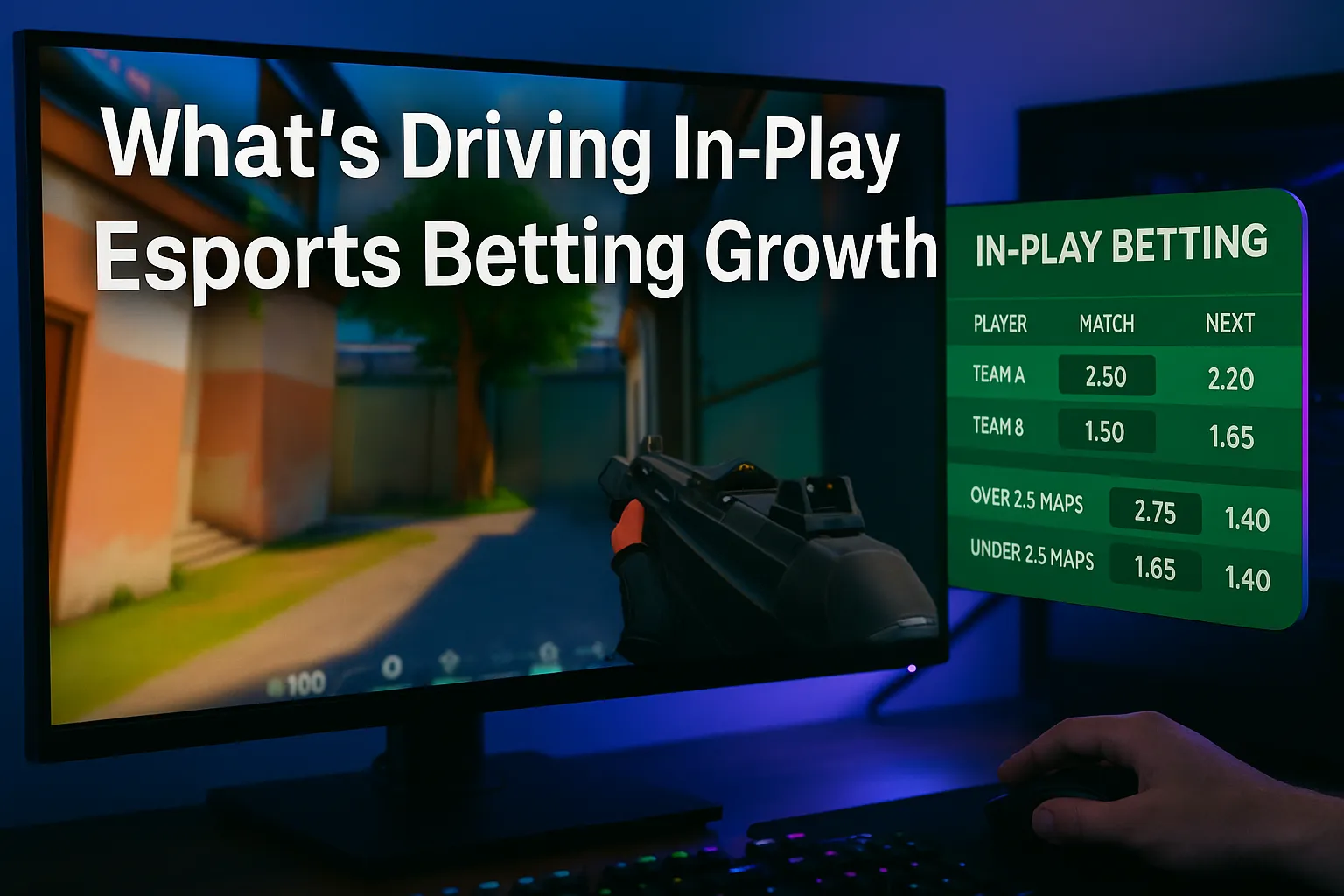Esports has grown from niche LAN parties to sold-out stadiums in less than a decade. Alongside that rise, the betting landscape has shifted dramatically. While traditional pre-match wagering remains popular, in-play esports betting—placing bets mid-match as the action unfolds—has emerged as a powerful growth driver for operators and fans alike. In this article, I’ll share insights from my own experiences in the gaming space and deep-dive into the factors fueling this phenomenon, with real-world examples and practical takeaways.
The Evolution of Esports & Live Betting
In the early days, esports events were sporadic and hard to follow live. Betting operators offered a handful of markets—match winner, map winner, sometimes a handicap—but once the game began, there was no turning back. As streaming platforms matured and latency dropped, fans could follow every grenade throw or clutch moment in real time. Operators seized the opportunity: by integrating data feeds directly into betting platforms, they began offering odds updates down to individual kills, round outcomes, and objective captures.
How Real-Time Data Changed the Game
My first encounter with in-play betting came during a Counter-Strike: Global Offensive tournament. I remember betting on whether the underdog would secure the pistol round and seeing odds update live after every single kill. That level of immersion drove me—and countless others—to stay glued to the stream while actively wagering. Today, the combination of robust APIs from tournament organizers and sophisticated frontend design means bettors can track dozens of dynamic markets without leaving their screens.
Key Drivers Behind the Growth of In-Play Esports Betting
When digging into why in-play esports betting has skyrocketed, three themes stand out: technology, audience behavior, and market diversity. Each feeds into the other in a virtuous cycle that keeps players engaged and operators innovating.
In many jurisdictions, platforms focused on non uk casinos have been early adopters of in-play features, recognizing that offering dynamic markets attracts both casual viewers and seasoned bettors. This willingness to innovate outside traditionally regulated environments has accelerated feature development and inspired licensed operators to follow suit.
Technological Advancements Fueling Real-Time Markets
Esports inherently lends itself to data-rich environments. Unlike traditional sports—where referee decisions and human factors limit data granularity—every event in an esports match generates a data point: kill, assist, objective captured, economy reset. Modern platforms apply streaming architectures and edge computing to ensure odds can update within milliseconds of an in-game event. That speed is critical; if odds lag by even a few seconds, sharp bettors can exploit delays, and the integrity of the market erodes.
Moreover, interactive UI elements—live heat maps showing control of key areas, micro-stats for individual players, and visual timers for clutch moments—transform a passive viewing experience into an active decision-making process. Operators have also begun exploring augmented reality overlays, enabling mobile bettors to point their camera at the stream and see live odds tags hover over player avatars.
Shifting Audience Expectations & Engagement
Esports fans tend to be younger and more tech-savvy than traditional sports audiences. They expect on-demand content, social chat integration, and instantaneous feedback loops. In-play betting satisfies those demands perfectly. Rather than placing a single pre-match bet and waiting for final outcomes, bettors can engage throughout—and even hedge positions as the match swings back and forth.
I’ve watched streamers encourage fans to jump into the odds board whenever they spot a momentum shift. That community-driven excitement creates social proof: when you see dozens of avatars lighting up on a Twitch overlay because viewers just backed a sudden comeback, you want to be part of the action. This social layer is far more potent than static pre-match promos or email newsletters.
Market Expansion & Regulatory Flexibility
Another key factor is market diversity. There are far more esports titles than mainstream sports, and each offers unique in-play possibilities. Whether it’s the round-by-round structure of CS:GO, the economic phases of Dota 2, or the split-second rotations in League of Legends, every game unlocks new betting angles. In turn, operators can curate markets around playstyle metrics (e.g., first turret in League, last-hit count in Dota) that keep even niche audiences engaged.
While tightly regulated markets (like the UK) have been cautious in approving rapid-fire in-play markets, non uk casinos and offshore operators have experimented freely, pushing boundaries on what’s permissible. This experimentation often leads to features that later make their way onto regulated platforms once compliance frameworks catch up.
Practical Insights for Bettors & Operators
For Bettors: Strategy & Risk Management
If you’re new to in-play esports betting, start small. Watch a few matches without betting to identify momentum indicators: team compositions that favor comeback strategies, maps that swing in one side’s favor at certain scorelines, and individual player tendencies under pressure. I keep a simple running log alongside my bets—time stamps, odds, outcomes—to build pattern recognition. Over time, you’ll notice, for instance, that Team X consistently wins pistols but struggles in subsequent eco rounds.
Also, hedge your positions. If you backed Team A at +120 early and they go down 0-2 in maps, consider laying off a portion of your stake before the final map if they tend to stage comebacks. Cash-out features vary by operator, so familiarize yourself with each platform’s mechanics before you need them.
For Operators: Balancing Speed, Integrity & UX
Operators looking to launch or improve in-play esports markets must invest in low-latency data pipelines and robust risk engines. It’s tempting to widen automated market creation to dozens of micro-markets, but each additional market multiplies the potential for mismatch if data feeds lag. A disciplined approach—launch with high-value markets, monitor for latency arbitrage, then gradually expand—works best.
UX also matters. Too many simultaneously updating markets can overwhelm even veteran bettors. Use heat maps to guide attention to key markets and allow users to customize their dashboards. Notifications for sudden odds shifts can keep users engaged without requiring constant screen monitoring.
Ethical Considerations & Responsible Play
Rapid-fire in-play betting carries a higher risk of impulsive wagering, particularly among younger demographics. Responsible operators should implement voluntary speed bumps—short delays before confirming large stake changes, optional cooling-off prompts after consecutive bets within a short time window, and clear visual indicators of net session profit/loss. Data shows that simple pop-ups reminding users of their time spent can reduce risky behavior by up to 15%.
On the bettor side, set strict session limits and stick to them. Use self-exclusion features if you notice impulse patterns. Betting on dynamic markets is exhilarating, but it’s still gambling; clear boundaries ensure enjoyment without undue harm.
The Road Ahead: Innovations & Trends
Looking forward, expect AI-driven predictive odds models that leverage in-session player performance metrics to anticipate swings before they happen. Some startups are already exploring smell-augmented stadia betting, where haptic alerts via wearables notify bettors of emerging opportunities. Cross-platform integration—betting through VR spectating experiences or social overlays embedded in Discord—will deepen engagement. As in-play esports betting matures, operators and regulators alike will need to collaborate on standards for data transparency, market fairness, and consumer protection.
Closing Thoughts
In-play esports betting represents a thrilling intersection of technology, entertainment, and wagering. For bettors, it offers a level of immersion and strategic depth unmatched by pre-match markets. For operators, it’s a potent retention tool that drives engagement and revenue. But with that power comes responsibility: we must safeguard players through design, education, and thoughtful regulation. By understanding the technical underpinnings and community dynamics, you can make smarter bets or build more sustainable platforms—and join the wave that’s driving the next chapter of esports betting.





